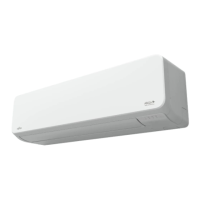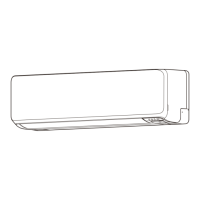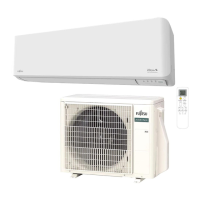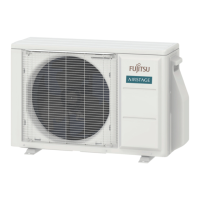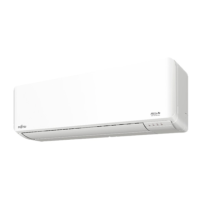En-5
WARNING
Always use the wall pipe. If the wall pipe is not used, the cable that is connected
between the indoor unit and the outdoor unit may touch metal, and cause an electric
discharge.
3.3.3. Installing the wall hook bracket
(1) Install the wall hook bracket so that it is correctly positioned horizontally and vertically.
If the wall hook bracket is titled, water will drip to the fl oor.
(2)
Install the wall hook bracket so that it is strong enough to support the weight of the unit.
• Fasten the wall hook bracket to the wall with 5 or more screws through the holes near
the outer edge of the bracket.
• Check that there is no rattle at the wall hook bracket.
Wall hook bracket
Screws (large, accessories)
CAUTION
Install the wall hook bracket both horizontally and vertically aligned.
Misaligned installation may cause water leakage.
3.3.4. Forming the drain hose and pipe
CAUTION
• Insert drain hose and drain cap securely. Drain should slope down to avoid water leakage.
• When inserting the drain hose, no other material than water should be applied.
Application of other material than water will cause deterioration of the hose, and may
cause water leakage.
• After you remove a drain hose, be sure to attach the drain cap.
• When you secure the piping and drain hose with tape, arrange the drain hose so that
it is at the bottom of the piping.
• For drain hose piping in low temperature environment, you need to apply freeze
protection to prevent a frozen drain hose.
After cooling operation is performed in low temperature environment (when outdoor
temperature under 32 °F [0 °C]), water in the drain hose could be frozen. Frozen
drain water will block the water fl ow in the hose, and may cause water leakage at the
indoor unit.
■
Right rear piping, Right piping, Right bottom piping
• Install the indoor unit piping in the direction of the wall hole and bind the drain hose
and pipe together with vinyl tape.
• Install the piping so that the drain hose is at the bottom.
• Wrap the pipes of the indoor unit that are visible from the outside with decorative tape.
Right piping
Bottom piping
Bind with vinyl tape
Refrigerant pipes (top)
Rear piping
Drain hose (bottom)
Drain hose (bottom)
■
For Left rear piping (Drain hose), Left piping (Drain hose), Left bottom
piping (Drain hose)
Interchange the drain cap and the drain hose.
■
Installing the drain cap
Use a hexagonal wrench 3/16 in (4 mm) at opposite side to insert the drain cap, till the
drain cap contacts the tip of the drain cock.
For left outlet piping
(Drain hose), cut
off the piping outlet
cutting groove with
a hacksaw.
Indoor unit
drain hose
Drain cap
Remove the drain cap by pull-
ing at the projection at the end
of the cap with pliers, etc.
No gap
Hexagonal
wrench
Drain
cock
Drain cap
Removing the drain hose
Remove the screw at the left of
drain hose and pull out drain hose.
Installing the drain hose
Vertically insert the drain hose toward the
inside, so that the drain fi xture (white) can ac-
curately align with the screw hole around the
drain cock.
After inserting and before replacing, Rein-
stall and fi x the removed screws.
• Hold around the joint of the drain hose during work.
•
As the screw is inside, be sure to use screwdrivers treated with magnet.
Screw
Drain fixture
Drain hose
Screw hole
Drain cock
Drain hose
Screw
Drain fixture
•
After passing the indoor piping and drain hose through the wall hole, hang the indoor unit on
the hooks at the top and bottom of the wall hook bracket.
CAUTION
Insert the drain hose and drain cap into the drain port, making sure that it comes
in contact with the back of the drain port, and then mount it. If the drain hose is not
connected properly, leaking will occur.
■
Installing the indoor unit
• Hang the indoor unit from the hooks at the top of the wall hook bracket.
• Insert the spacer, etc. within the area(gray insulation) between the indoor unit and the
wall hook bracket and separate the bottom of the indoor unit from the wall.
Connection pipe small Align the marks
Bend R2-3/4 (R70) with a pipe bender
Connection pipe large
Unit: in (mm)
Top hooks
Indoor unit
Center of upper rail
Gray insulation
(Spacer’s area)
(Fittings) Bottom hooks
Wall hook bracket
(Spacer)
• After hooking the indoor unit to the top hook, hook the fi ttings of the indoor unit to the
bottom hooks while lowering the unit and pushing it against the wall.
3.3.5. Pipe connection
CAUTION
Tighten the fl are nuts with a torque wrench using the specifi ed tightening method.
Otherwise, the fl are nuts could break after a prolonged period, causing refrigerant to
leak and generate hazardous gas if the refrigerant comes into contact with a fl ame.
■
Flaring
Use special pipe cutter and fl are tool exclusive for R410A.
(1) Cut the connection pipe to the necessary length with a pipe cutter.
(2) Hold the pipe downward so that cuttings will not enter the pipe and remove any burrs.
(3) Insert the fl are nut (always use the fl are nut attached to the indoor unit(s) and outdoor
unit respectively) onto the pipe and perform the fl are processing with a fl are tool. Use
the special R410A fl are tool, or the conventional fl are tool. Leakage of refrigerant may
result if other fl are nuts are used.
(4) Protect the pipes by pinching them or with tape to prevent dust, dirt, or water from
entering the pipes.
Die
A
Pipe
B
L
Check if [L] is flared uniformly
and is not cracked or scratched.
9387603217-01_IM.indb 59387603217-01_IM.indb 5 20-Jul-21 16:06:2620-Jul-21 16:06:26

